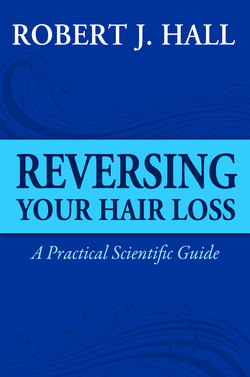Читать книгу Reversing Your Hair Loss - A Practical Scientific Guide - Robert J. Hall - Страница 10
На сайте Литреса книга снята с продажи.
Chapter Six Hair Structure
ОглавлениеContrary to its external appearance, every strand of hair is a complex, well-organised, multi-layered, structure and not just a simple fibre of some sort. It is, in fact, a strong, flexible, self-coloured tube made of at least two layers of specialised skin bonded together with an integral outer coating of water sealant.
Cutting a strand of hair across the width of its diameter will give a cross-sectional picture of the hair shaft and, apart from showing its distinctive racial type, will also exhibit three distinct zones of physical differentiation.
On the outside is the cuticle. This is composed of a layer of very flat, thin, dead cells that overlap one another, much like the tiles on a roof. They are coated with an extremely thin layer of a hard, waxy substance only a few molecules deep. This natural coating causes the cuticle layer to repel water and is especially effective in ulotrichous hair. The effect is augmented by further secretions from the sebaceous glands coming from inside the follicle.
When the cuticle’s ‘tiles’ are laying down flat, the hair is smooth and shiny; however, some hair treatments can cause these tiles to lift up. Treatments that have decidedly high pH levels (that are alkaline, in other words) are notorious in this respect. Once this has happened, the hair becomes rough, dull and much more easily tangled as the uplifted tiles of one strand mesh into the uplifted tiles of another. Pulling a comb or brush through such hair can damage the already weakened shafts even further and will cause considerable pain. In some severe cases, the only option is to cut the truly matted hair back to just above skin level. This applies to animals as well as humans.
The next layer is the called the cortex, and it is this layer that provides the hair with its strength, thickness and colour. Only here are intra-cellular grains of the two pigments found, as well as bundles of keratin rods. Although this cortex layer absorbs water quite well the keratin itself within it is insoluble.
Keratin is a supremely tough structural protein that, in hair, organises itself into microscopic filaments made up of aligned bundles. Laid end to end to form spiral plaits, these keratin rods impart huge strength to various physical structures within the animal kingdom. Keratin makes up not only our hair and nails, but also sheep’s wool, bird beaks, animal claws, rhinoceros horns, bird feathers, tortoise shells, hedgehog spines and elephant tusks, to name but just a few of them.
Keratin does have a weakness, however. It is a protein and is, therefore, susceptible to being used for food by other organisms. Fungal infections on the skin like athletes foot and ringworm (Tinea pedis and dermatophytosis respectively) occur because the fungi involved do exactly this. They actually break the keratin down and feed upon it.
The innermost layer is called the medulla. In some people’s hair, this area is simply an empty space. In others it contains a loose, disorganised mass of weak and mostly disconnected cells. From the outside, it is impossible to tell whether the medulla in any particular strand of hair is empty or not. Either way, it appears not to make much difference to anything.
